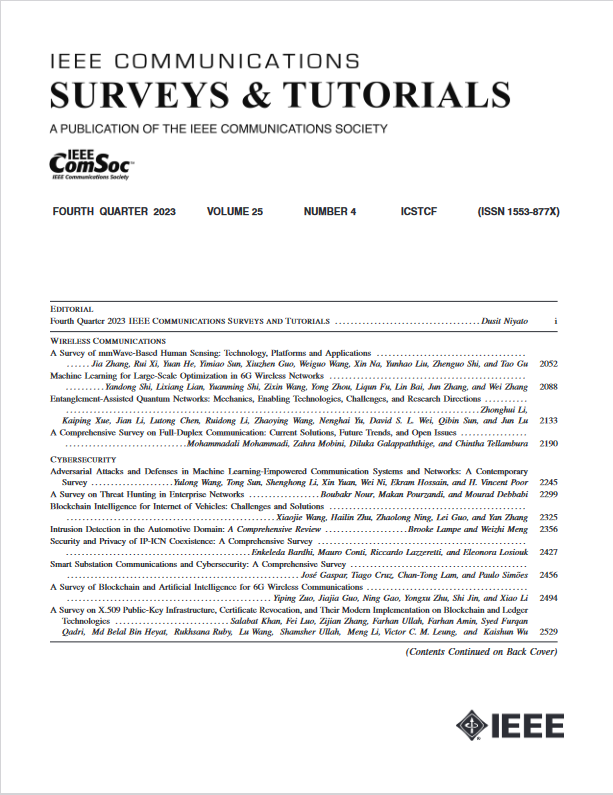Intrusion Detection in the Automotive Domain: A Comprehensive Review
IF 34.4
1区 计算机科学
Q1 COMPUTER SCIENCE, INFORMATION SYSTEMS
引用次数: 0
Abstract
The automotive domain has realized amazing advancements in communication, connectivity, and automation—and at a breakneck pace. Such advancements come with ample benefits, such as the reduction of traffic accidents and the refinement of transit efficiency. However, these new developments were not necessarily made with security in mind. Researchers have unearthed a number of security vulnerabilities in paradigms such as in-vehicle networks (IVNs), the Internet of Vehicles (IoV), and intelligent transportation systems (ITSs). As automotive technologies continue to evolve, it would be realistic to expect new vulnerabilities to arise—both vulnerabilities that are identified and vulnerabilities that are not. If—or more pragmatically, when—these vulnerabilities are exploited, intrusion detection will be paramount. Therefore, we find it prudent to review intrusion detection in the automotive domain. We explore a myriad of threats and intrusion detection techniques—from the boundaries of the vehicle’s own network to the wider Internet of Vehicles (IoV). Intrusion detection, while not a panacea, can be a cost-effective solution to many automotive security issues. Generally, such intrusion detection systems (IDSs) do not disrupt existing hardware, infrastructure, or communications; rather, they merely tap into the network and monitor for suspicious traffic. Given the very reasonable price tag, the implementation of intrusion detection systems would be an auspicious step by the automotive industry to assure the security—and safety—of the modern automobile. This paper volunteers a comprehensive review of intrusion detection technologies in the automotive domain.汽车领域的入侵检测:综述
汽车领域在通信、连接和自动化方面取得了惊人的进步,而且速度惊人。这些进步带来了很多好处,比如交通事故的减少和交通效率的提高。然而,这些新的发展并不一定是考虑到安全。研究人员在车载网络(IVNs)、车联网(IoV)和智能交通系统(ITSs)等范例中发现了许多安全漏洞。随着汽车技术的不断发展,预计新的漏洞将会出现——包括已识别的漏洞和未识别的漏洞。如果——或者更实际地说,当——这些漏洞被利用时,入侵检测将是至关重要的。因此,我们认为回顾汽车领域的入侵检测是明智的。我们探索了无数的威胁和入侵检测技术——从车辆自身网络的边界到更广泛的车联网(IoV)。入侵检测虽然不是万灵药,但对于许多汽车安全问题来说,它是一种经济有效的解决方案。一般来说,这种入侵检测系统(ids)不会破坏现有的硬件、基础设施或通信;相反,他们只是进入网络并监控可疑的流量。考虑到非常合理的价格标签,入侵检测系统的实施将是汽车行业确保现代汽车安全的一个吉祥的步骤。本文对汽车领域的入侵检测技术进行了综述。
本文章由计算机程序翻译,如有差异,请以英文原文为准。
求助全文
约1分钟内获得全文
求助全文
来源期刊

IEEE Communications Surveys and Tutorials
COMPUTER SCIENCE, INFORMATION SYSTEMS-TELECOMMUNICATIONS
CiteScore
80.20
自引率
2.50%
发文量
84
审稿时长
6 months
期刊介绍:
IEEE Communications Surveys & Tutorials is an online journal published by the IEEE Communications Society for tutorials and surveys covering all aspects of the communications field. Telecommunications technology is progressing at a rapid pace, and the IEEE Communications Society is committed to providing researchers and other professionals the information and tools to stay abreast. IEEE Communications Surveys and Tutorials focuses on integrating and adding understanding to the existing literature on communications, putting results in context. Whether searching for in-depth information about a familiar area or an introduction into a new area, IEEE Communications Surveys & Tutorials aims to be the premier source of peer-reviewed, comprehensive tutorials and surveys, and pointers to further sources. IEEE Communications Surveys & Tutorials publishes only articles exclusively written for IEEE Communications Surveys & Tutorials and go through a rigorous review process before their publication in the quarterly issues.
A tutorial article in the IEEE Communications Surveys & Tutorials should be designed to help the reader to become familiar with and learn something specific about a chosen topic. In contrast, the term survey, as applied here, is defined to mean a survey of the literature. A survey article in IEEE Communications Surveys & Tutorials should provide a comprehensive review of developments in a selected area, covering its development from its inception to its current state and beyond, and illustrating its development through liberal citations from the literature. Both tutorials and surveys should be tutorial in nature and should be written in a style comprehensible to readers outside the specialty of the article.
 求助内容:
求助内容: 应助结果提醒方式:
应助结果提醒方式:


